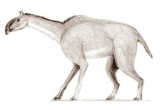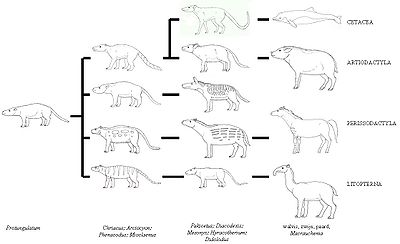
Litopterna
Encyclopedia
Litopterna is an extinct
order of fossil
hoofed mammal
s (ungulate
s) from the Tertiary
period that displays toe reduction. Three-toed, and even a one-toed horselike form developed.
This order, known only from South America
, was common and varied in early faunas and persisted, in decreasing variety, into the Pleistocene
. Early forms are near the condylarth
s, to such an extent that the litopterns might be considered merely as surviving and diversely specialized condylarths. They are suspected of being descended from South American condylarths, and therefore to have the same source as the latter. However, there is a growing number of scientists who believes the Litopterna (together with other South-American ungulates) originated completely independently from the other ungulates, thus are unrelated to the condylarths. They proposed a new clade to contain these groups: the Meridiungulata
. Macrauchenia
was the youngest genus of litopterns, and was the only litoptern group to survive the Great American Interchange
; it died out at the end of the Pleistocene
.
The Litopterna, like the notoungulates
and pyrotheres
, are examples of ungulate mammals that arose relatively independently in "splendid isolation
" on the island continent of South America. Like Australia
, South America was isolated from all other continents following the breakup of Gondwana
. During this period of isolation, unique mammals evolved to fill ecological niche
s similar to other mammals elsewhere. The Litopterna occupied ecological roles as browsers and grazers similar to horses and camel
s in Laurasia
.

Extinction
In biology and ecology, extinction is the end of an organism or of a group of organisms , normally a species. The moment of extinction is generally considered to be the death of the last individual of the species, although the capacity to breed and recover may have been lost before this point...
order of fossil
Fossil
Fossils are the preserved remains or traces of animals , plants, and other organisms from the remote past...
hoofed mammal
Mammal
Mammals are members of a class of air-breathing vertebrate animals characterised by the possession of endothermy, hair, three middle ear bones, and mammary glands functional in mothers with young...
s (ungulate
Ungulate
Ungulates are several groups of mammals, most of which use the tips of their toes, usually hoofed, to sustain their whole body weight while moving. They make up several orders of mammals, of which six to eight survive...
s) from the Tertiary
Tertiary
The Tertiary is a deprecated term for a geologic period 65 million to 2.6 million years ago. The Tertiary covered the time span between the superseded Secondary period and the Quaternary...
period that displays toe reduction. Three-toed, and even a one-toed horselike form developed.
This order, known only from South America
South America
South America is a continent situated in the Western Hemisphere, mostly in the Southern Hemisphere, with a relatively small portion in the Northern Hemisphere. The continent is also considered a subcontinent of the Americas. It is bordered on the west by the Pacific Ocean and on the north and east...
, was common and varied in early faunas and persisted, in decreasing variety, into the Pleistocene
Pleistocene
The Pleistocene is the epoch from 2,588,000 to 11,700 years BP that spans the world's recent period of repeated glaciations. The name pleistocene is derived from the Greek and ....
. Early forms are near the condylarth
Condylarth
Condylarthra is an order of extinct placental mammals known primarily from the Paleocene and Eocene epochs. Condylarths are among the most characteristic Paleocene mammals and they illustrate the evolutionary level of the Paleocene mammal fauna....
s, to such an extent that the litopterns might be considered merely as surviving and diversely specialized condylarths. They are suspected of being descended from South American condylarths, and therefore to have the same source as the latter. However, there is a growing number of scientists who believes the Litopterna (together with other South-American ungulates) originated completely independently from the other ungulates, thus are unrelated to the condylarths. They proposed a new clade to contain these groups: the Meridiungulata
Meridiungulata
Meridiungulata is an extinct clade with the rank of cohort or super-order, containing the South-American ungulates: Pyrotheria , Astrapotheria, Notoungulata and Litopterna...
. Macrauchenia
Macrauchenia
Macrauchenia was a long-necked and long-limbed, three-toed South American ungulate mammal, typifying the order Litopterna. The oldest fossils date back to around 7 million years ago, and M...
was the youngest genus of litopterns, and was the only litoptern group to survive the Great American Interchange
Great American Interchange
The Great American Interchange was an important paleozoogeographic event in which land and freshwater fauna migrated from North America via Central America to South America and vice versa, as the volcanic Isthmus of Panama rose up from the sea floor and bridged the formerly separated continents...
; it died out at the end of the Pleistocene
Pleistocene
The Pleistocene is the epoch from 2,588,000 to 11,700 years BP that spans the world's recent period of repeated glaciations. The name pleistocene is derived from the Greek and ....
.
The Litopterna, like the notoungulates
Notoungulata
Notoungulata is an extinct order of hoofed, sometimes heavy bodied mammalian ungulates which inhabited South America during the Paleocene to Pleistocene, living from approximately 57 Ma to 11,000 years ago.-Taxonomy:...
and pyrotheres
Pyrotheria
Pyrotheria is an order of extinct meridiungulate mammals. These mastodon-like ungulates include the genera Baguatherium, Carolozittelia, Colombitherium, Gryphodon, Propyrotherium, Proticia, and Pyrotherium....
, are examples of ungulate mammals that arose relatively independently in "splendid isolation
Splendid isolation
Splendid Isolation was the foreign policy pursued by Britain during the late 19th century, under the Conservative premierships of Benjamin Disraeli and the Marquess of Salisbury. The term was actually coined by a Canadian politician to praise Britain's lack of involvement in European affairs...
" on the island continent of South America. Like Australia
Australia
Australia , officially the Commonwealth of Australia, is a country in the Southern Hemisphere comprising the mainland of the Australian continent, the island of Tasmania, and numerous smaller islands in the Indian and Pacific Oceans. It is the world's sixth-largest country by total area...
, South America was isolated from all other continents following the breakup of Gondwana
Gondwana
In paleogeography, Gondwana , originally Gondwanaland, was the southernmost of two supercontinents that later became parts of the Pangaea supercontinent. It existed from approximately 510 to 180 million years ago . Gondwana is believed to have sutured between ca. 570 and 510 Mya,...
. During this period of isolation, unique mammals evolved to fill ecological niche
Ecological niche
In ecology, a niche is a term describing the relational position of a species or population in its ecosystem to each other; e.g. a dolphin could potentially be in another ecological niche from one that travels in a different pod if the members of these pods utilize significantly different food...
s similar to other mammals elsewhere. The Litopterna occupied ecological roles as browsers and grazers similar to horses and camel
Camel
A camel is an even-toed ungulate within the genus Camelus, bearing distinctive fatty deposits known as humps on its back. There are two species of camels: the dromedary or Arabian camel has a single hump, and the bactrian has two humps. Dromedaries are native to the dry desert areas of West Asia,...
s in Laurasia
Laurasia
In paleogeography, Laurasia was the northernmost of two supercontinents that formed part of the Pangaea supercontinent from approximately...
.
Families of Litopterns
- Order Litopterna - Litopterans (all members of the order extinct South American forms)
- Family Protolipternidae - incertae sedisIncertae sedis, is a term used to define a taxonomic group where its broader relationships are unknown or undefined. Uncertainty at specific taxonomic levels is attributed by , , and similar terms.-Examples:*The fossil plant Paradinandra suecica could not be assigned to any...
- Superfamily Macrauchenioidea
- Family MacraucheniidaeMacraucheniidaeMacraucheniidae is a family in the Litopterna order of extinct South American ungulates. The recessed nasal bones of their skulls suggest that they may have had a small proboscis, or trunk. Their hooves were similar to those of rhinoceroses today, with a simple ankle joint and three digits on each...
- Family Notonychopidae
- Family Adianthidae
- Family Macraucheniidae
- Superfamily Proterotherioidea
- Family ProterotheriidaeProterotheriidaeProterotheriidae is an extinct family of fossil ungulates from the Tertiary period that displays toe reduction. Despite resembling primitive, small horses, they were not related to them, but belonged to the order Litopterna....
- Family Proterotheriidae
- Family Protolipternidae - incertae sedis
Proposed ancestry
This tree shows a proposed ancestry of several mammals including the Litopterna (walvis=whale, zwijn=pig, paard=horse):
External links
- An artist's rendition of a MacraucheniaMacraucheniaMacrauchenia was a long-necked and long-limbed, three-toed South American ungulate mammal, typifying the order Litopterna. The oldest fossils date back to around 7 million years ago, and M...
, a representative genus of the Litopterna. Retrieved from the Red Académica Uruguaya megafauna page.

